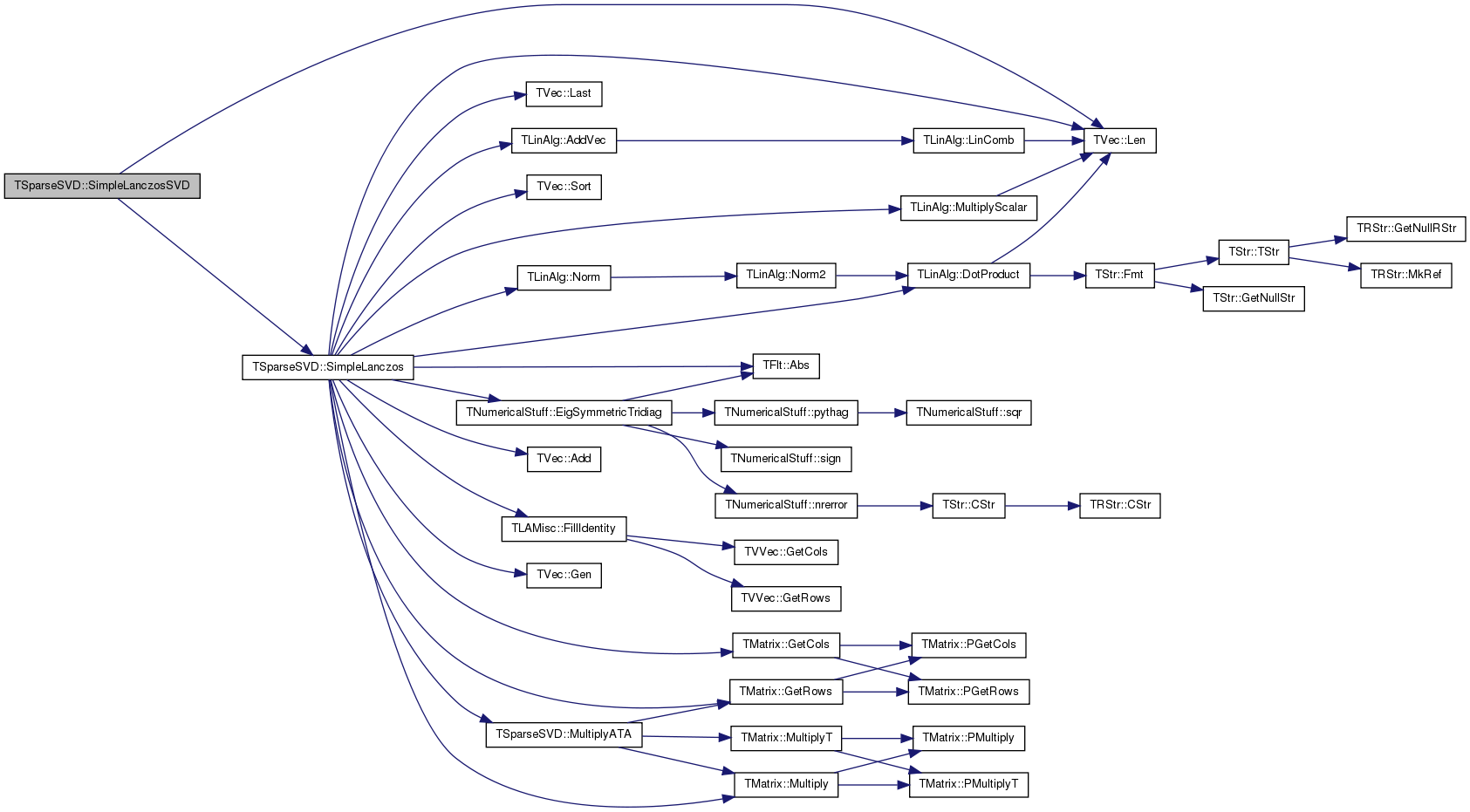|
SNAP Library 2.1, Developer Reference
2013-09-25 10:47:25
SNAP, a general purpose, high performance system for analysis and manipulation of large networks
|
|
SNAP Library 2.1, Developer Reference
2013-09-25 10:47:25
SNAP, a general purpose, high performance system for analysis and manipulation of large networks
|
#include <linalg.h>
Static Public Member Functions | |
| static void | SimpleLanczos (const TMatrix &Matrix, const int &NumEig, TFltV &EigValV, const bool &DoLocalReortoP=false, const bool &SvdMatrixProductP=false) |
| static void | Lanczos (const TMatrix &Matrix, int NumEig, int Iters, const TSpSVDReOrtoType &ReOrtoType, TFltV &EigValV, TFltVV &EigVecVV, const bool &SvdMatrixProductP=false) |
| static void | Lanczos2 (const TMatrix &Matrix, int MaxNumEig, int MaxSecs, const TSpSVDReOrtoType &ReOrtoType, TFltV &EigValV, TFltVV &EigVecVV, const bool &SvdMatrixProductP=false) |
| static void | SimpleLanczosSVD (const TMatrix &Matrix, const int &CalcSV, TFltV &SngValV, const bool &DoLocalReortoP=false) |
| static void | LanczosSVD (const TMatrix &Matrix, int NumSV, int Iters, const TSpSVDReOrtoType &ReOrtoType, TFltV &SgnValV, TFltVV &LeftSgnVecVV, TFltVV &RightSgnVecVV) |
| static void | OrtoIterSVD (const TMatrix &Matrix, int NumSV, int IterN, TFltV &SgnValV) |
| static void | Project (const TIntFltKdV &Vec, const TFltVV &U, TFltV &ProjVec) |
Static Private Member Functions | |
| static void | MultiplyATA (const TMatrix &Matrix, const TFltVV &Vec, int ColId, TFltV &Result) |
| static void | MultiplyATA (const TMatrix &Matrix, const TFltV &Vec, TFltV &Result) |
| void TSparseSVD::Lanczos | ( | const TMatrix & | Matrix, |
| int | NumEig, | ||
| int | Iters, | ||
| const TSpSVDReOrtoType & | ReOrtoType, | ||
| TFltV & | EigValV, | ||
| TFltVV & | EigVecVV, | ||
| const bool & | SvdMatrixProductP = false |
||
| ) | [static] |
Definition at line 1131 of file linalg.cpp.
References TFlt::Abs(), TVec< TVal, TSizeTy >::Add(), TLinAlg::AddVec(), TLinAlg::DotProduct(), TNumericalStuff::EigSymmetricTridiag(), TStr::Fmt(), TVVec< TVal >::Gen(), TMatrix::GetCols(), TInt::GetMn(), TFlt::GetMx(), TMatrix::GetRows(), IAssert, IAssertR, TMatrix::Multiply(), TLinAlg::Multiply(), MultiplyATA(), TLinAlg::Norm(), TVec< TVal, TSizeTy >::Reserve(), TVec< TVal, TSizeTy >::Sort(), ssotFull, and ssotSelective.
Referenced by TSnap::GetEigVals(), TSnap::GetEigVec(), and LanczosSVD().
{
if (SvdMatrixProductP) {
// if this fails, use transposed matrix
IAssert(Matrix.GetRows() >= Matrix.GetCols());
} else {
IAssert(Matrix.GetRows() == Matrix.GetCols());
}
IAssertR(NumEig <= Iters, TStr::Fmt("%d <= %d", NumEig, Iters));
//if (ReOrtoType == ssotFull) printf("Full reortogonalization\n");
int i, N = Matrix.GetCols(), K; // K - current dimension of T
double t = 0.0, eps = 1e-6; // t - 1-norm of T
//sequence of Ritz's vectors
TFltVV Q(N, Iters);
double tmp = 1/sqrt((double)N);
for (i = 0; i < N; i++)
Q(i,0) = tmp;
//converget Ritz's vectors
TVec<TFltV> ConvgQV(Iters);
TIntV CountConvgV(Iters);
for (i = 0; i < Iters; i++) CountConvgV[i] = 0;
// const int ConvgTreshold = 50;
//diagonal and subdiagonal of T
TFltV d(Iters+1), e(Iters+1);
//eigenvectors of T
//TFltVV V;
TFltVV V(Iters, Iters);
// z - current Lanczos's vector
TFltV z(N), bb(Iters), aa(Iters), y(N);
//printf("svd(%d,%d)...\n", NumEig, Iters);
if (SvdMatrixProductP) {
// A = Matrix'*Matrix
MultiplyATA(Matrix, Q, 0, z);
} else {
// A = Matrix
Matrix.Multiply(Q, 0, z);
}
for (int j = 0; j < (Iters-1); j++) {
//printf("%d..\r",j+2);
//calculates (j+1)-th Lanczos's vector
// aa[j] = <Q(:,j), z>
aa[j] = TLinAlg::DotProduct(Q, j, z);
//printf(" %g -- ", aa[j].Val); //HACK
TLinAlg::AddVec(-aa[j], Q, j, z);
if (j > 0) {
// z := -aa[j] * Q(:,j) + z
TLinAlg::AddVec(-bb[j-1], Q, j-1, z);
//reortogonalization
if (ReOrtoType == ssotSelective || ReOrtoType == ssotFull) {
for (i = 0; i <= j; i++) {
// if i-tj vector converget, than we have to ortogonalize against it
if ((ReOrtoType == ssotFull) ||
(bb[j-1] * TFlt::Abs(V(K-1, i)) < eps * t)) {
ConvgQV[i].Reserve(N,N); CountConvgV[i]++;
TFltV& vec = ConvgQV[i];
//vec = Q * V(:,i)
for (int k = 0; k < N; k++) {
vec[k] = 0.0;
for (int l = 0; l < K; l++)
vec[k] += Q(k,l) * V(l,i);
}
TLinAlg::AddVec(-TLinAlg::DotProduct(ConvgQV[i], z), ConvgQV[i], z ,z);
}
}
}
}
//adds (j+1)-th Lanczos's vector to Q
bb[j] = TLinAlg::Norm(z);
if (!(bb[j] > 1e-10)) {
printf("Rank of matrix is only %d\n", j+2);
printf("Last singular value is %g\n", bb[j].Val);
break;
}
for (i = 0; i < N; i++)
Q(i, j+1) = z[i] / bb[j];
//next Lanzcos vector
if (SvdMatrixProductP) {
// A = Matrix'*Matrix
MultiplyATA(Matrix, Q, j+1, z);
} else {
// A = Matrix
Matrix.Multiply(Q, j+1, z);
}
//calculate T (K x K matrix)
K = j + 2;
// calculate diagonal
for (i = 1; i < K; i++) d[i] = aa[i-1];
d[K] = TLinAlg::DotProduct(Q, K-1, z);
// calculate subdiagonal
e[1] = 0.0;
for (i = 2; i <= K; i++) e[i] = bb[i-2];
//calculate 1-norm of T
t = TFlt::GetMx(TFlt::Abs(d[1]) + TFlt::Abs(e[2]), TFlt::Abs(e[K]) + TFlt::Abs(d[K]));
for (i = 2; i < K; i++)
t = TFlt::GetMx(t, TFlt::Abs(e[i]) + TFlt::Abs(d[i]) + TFlt::Abs(e[i+1]));
//set V to identity matrix
//V.Gen(K,K);
for (i = 0; i < K; i++) {
for (int k = 0; k < K; k++)
V(i,k) = 0.0;
V(i,i) = 1.0;
}
//eigenvectors of T
TNumericalStuff::EigSymmetricTridiag(d, e, K, V);
}//for
//printf("\n");
// Finds NumEig largest eigen values
TFltIntKdV sv(K);
for (i = 0; i < K; i++) {
sv[i].Key = TFlt::Abs(d[i+1]);
sv[i].Dat = i;
}
sv.Sort(false);
TFltV uu(Matrix.GetRows());
const int FinalNumEig = TInt::GetMn(NumEig, K);
EigValV.Reserve(FinalNumEig,0);
EigVecVV.Gen(Matrix.GetCols(), FinalNumEig);
for (i = 0; i < FinalNumEig; i++) {
//printf("s[%d] = %20.15f\r", i, sv[i].Key.Val);
int ii = sv[i].Dat;
double sigma = d[ii+1].Val;
// calculate singular value
EigValV.Add(sigma);
// calculate i-th right singular vector ( V := Q * W )
TLinAlg::Multiply(Q, V, ii, EigVecVV, i);
}
//printf("done \n");
}
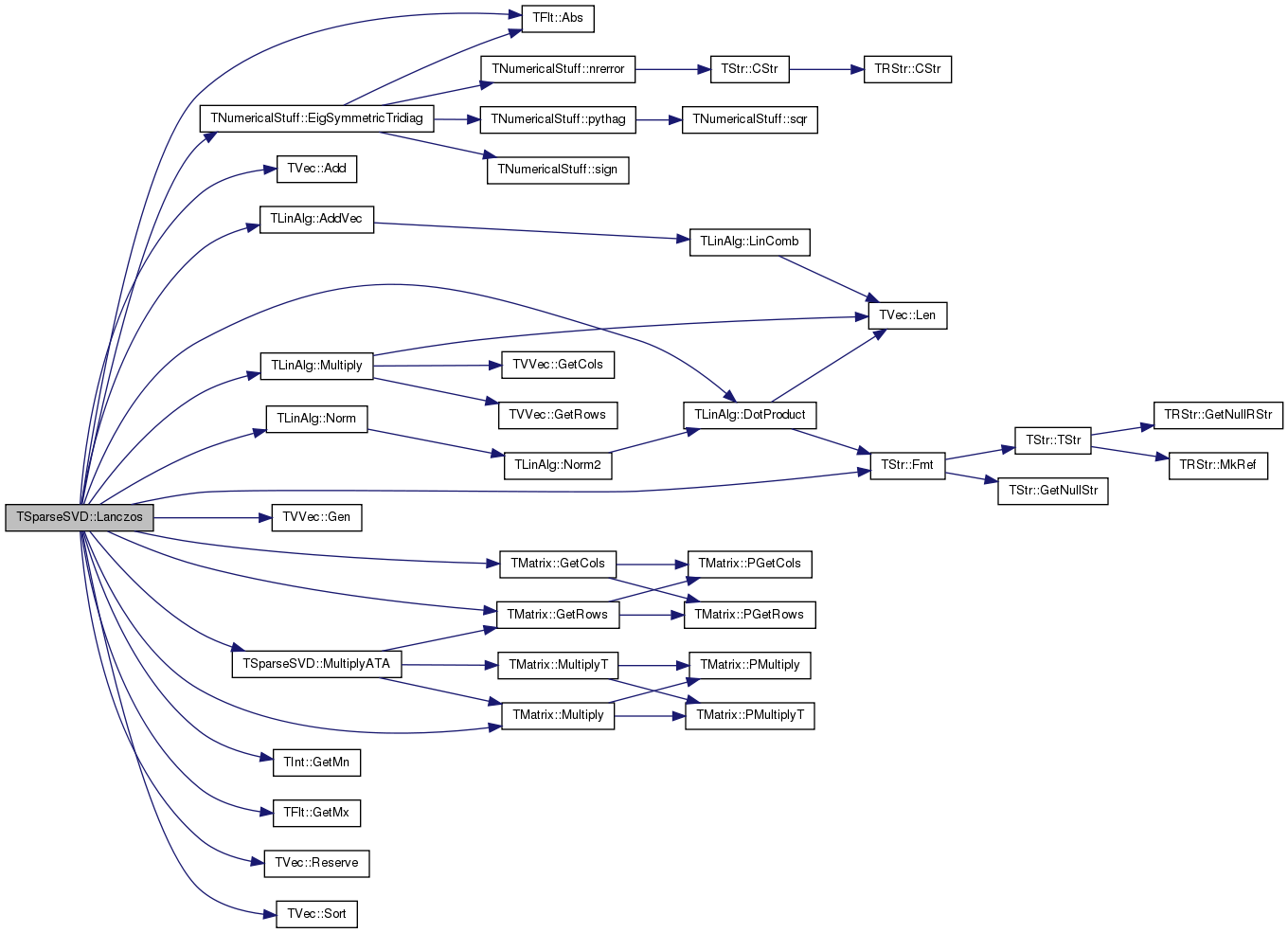

| void TSparseSVD::Lanczos2 | ( | const TMatrix & | Matrix, |
| int | MaxNumEig, | ||
| int | MaxSecs, | ||
| const TSpSVDReOrtoType & | ReOrtoType, | ||
| TFltV & | EigValV, | ||
| TFltVV & | EigVecVV, | ||
| const bool & | SvdMatrixProductP = false |
||
| ) | [static] |
Definition at line 1280 of file linalg.cpp.
References TFlt::Abs(), TVec< TVal, TSizeTy >::Add(), TLinAlg::AddVec(), TLinAlg::DotProduct(), TNumericalStuff::EigSymmetricTridiag(), TVVec< TVal >::Gen(), TMatrix::GetCols(), TFlt::GetMx(), TMatrix::GetRows(), TExeTm::GetSecs(), TExeTm::GetStr(), IAssert, TMatrix::Multiply(), TLinAlg::Multiply(), MultiplyATA(), TLinAlg::Norm(), TVec< TVal, TSizeTy >::Reserve(), TVec< TVal, TSizeTy >::Sort(), ssotFull, and ssotSelective.
Referenced by TSnap::GetInvParticipRat().
{
if (SvdMatrixProductP) {
// if this fails, use transposed matrix
IAssert(Matrix.GetRows() >= Matrix.GetCols());
} else {
IAssert(Matrix.GetRows() == Matrix.GetCols());
}
//IAssertR(NumEig <= Iters, TStr::Fmt("%d <= %d", NumEig, Iters));
//if (ReOrtoType == ssotFull) printf("Full reortogonalization\n");
int i, N = Matrix.GetCols(), K; // K - current dimension of T
double t = 0.0, eps = 1e-6; // t - 1-norm of T
//sequence of Ritz's vectors
TFltVV Q(N, MaxNumEig);
double tmp = 1/sqrt((double)N);
for (i = 0; i < N; i++)
Q(i,0) = tmp;
//converget Ritz's vectors
TVec<TFltV> ConvgQV(MaxNumEig);
TIntV CountConvgV(MaxNumEig);
for (i = 0; i < MaxNumEig; i++) CountConvgV[i] = 0;
// const int ConvgTreshold = 50;
//diagonal and subdiagonal of T
TFltV d(MaxNumEig+1), e(MaxNumEig+1);
//eigenvectors of T
//TFltVV V;
TFltVV V(MaxNumEig, MaxNumEig);
// z - current Lanczos's vector
TFltV z(N), bb(MaxNumEig), aa(MaxNumEig), y(N);
//printf("svd(%d,%d)...\n", NumEig, Iters);
if (SvdMatrixProductP) {
// A = Matrix'*Matrix
MultiplyATA(Matrix, Q, 0, z);
} else {
// A = Matrix
Matrix.Multiply(Q, 0, z);
}
TExeTm ExeTm;
for (int j = 0; j < (MaxNumEig-1); j++) {
printf("%d [%s]..\r",j+2, ExeTm.GetStr());
if (ExeTm.GetSecs() > MaxSecs) { break; }
//calculates (j+1)-th Lanczos's vector
// aa[j] = <Q(:,j), z>
aa[j] = TLinAlg::DotProduct(Q, j, z);
//printf(" %g -- ", aa[j].Val); //HACK
TLinAlg::AddVec(-aa[j], Q, j, z);
if (j > 0) {
// z := -aa[j] * Q(:,j) + z
TLinAlg::AddVec(-bb[j-1], Q, j-1, z);
//reortogonalization
if (ReOrtoType == ssotSelective || ReOrtoType == ssotFull) {
for (i = 0; i <= j; i++) {
// if i-tj vector converget, than we have to ortogonalize against it
if ((ReOrtoType == ssotFull) ||
(bb[j-1] * TFlt::Abs(V(K-1, i)) < eps * t)) {
ConvgQV[i].Reserve(N,N); CountConvgV[i]++;
TFltV& vec = ConvgQV[i];
//vec = Q * V(:,i)
for (int k = 0; k < N; k++) {
vec[k] = 0.0;
for (int l = 0; l < K; l++)
vec[k] += Q(k,l) * V(l,i);
}
TLinAlg::AddVec(-TLinAlg::DotProduct(ConvgQV[i], z), ConvgQV[i], z ,z);
}
}
}
}
//adds (j+1)-th Lanczos's vector to Q
bb[j] = TLinAlg::Norm(z);
if (!(bb[j] > 1e-10)) {
printf("Rank of matrix is only %d\n", j+2);
printf("Last singular value is %g\n", bb[j].Val);
break;
}
for (i = 0; i < N; i++)
Q(i, j+1) = z[i] / bb[j];
//next Lanzcos vector
if (SvdMatrixProductP) {
// A = Matrix'*Matrix
MultiplyATA(Matrix, Q, j+1, z);
} else {
// A = Matrix
Matrix.Multiply(Q, j+1, z);
}
//calculate T (K x K matrix)
K = j + 2;
// calculate diagonal
for (i = 1; i < K; i++) d[i] = aa[i-1];
d[K] = TLinAlg::DotProduct(Q, K-1, z);
// calculate subdiagonal
e[1] = 0.0;
for (i = 2; i <= K; i++) e[i] = bb[i-2];
//calculate 1-norm of T
t = TFlt::GetMx(TFlt::Abs(d[1]) + TFlt::Abs(e[2]), TFlt::Abs(e[K]) + TFlt::Abs(d[K]));
for (i = 2; i < K; i++)
t = TFlt::GetMx(t, TFlt::Abs(e[i]) + TFlt::Abs(d[i]) + TFlt::Abs(e[i+1]));
//set V to identity matrix
//V.Gen(K,K);
for (i = 0; i < K; i++) {
for (int k = 0; k < K; k++)
V(i,k) = 0.0;
V(i,i) = 1.0;
}
//eigenvectors of T
TNumericalStuff::EigSymmetricTridiag(d, e, K, V);
}//for
printf("... calc %d.", K);
// Finds NumEig largest eigen values
TFltIntKdV sv(K);
for (i = 0; i < K; i++) {
sv[i].Key = TFlt::Abs(d[i+1]);
sv[i].Dat = i;
}
sv.Sort(false);
TFltV uu(Matrix.GetRows());
const int FinalNumEig = K; //TInt::GetMn(NumEig, K);
EigValV.Reserve(FinalNumEig,0);
EigVecVV.Gen(Matrix.GetCols(), FinalNumEig);
for (i = 0; i < FinalNumEig; i++) {
//printf("s[%d] = %20.15f\r", i, sv[i].Key.Val);
int ii = sv[i].Dat;
double sigma = d[ii+1].Val;
// calculate singular value
EigValV.Add(sigma);
// calculate i-th right singular vector ( V := Q * W )
TLinAlg::Multiply(Q, V, ii, EigVecVV, i);
}
printf(" done\n");
}


| void TSparseSVD::LanczosSVD | ( | const TMatrix & | Matrix, |
| int | NumSV, | ||
| int | Iters, | ||
| const TSpSVDReOrtoType & | ReOrtoType, | ||
| TFltV & | SgnValV, | ||
| TFltVV & | LeftSgnVecVV, | ||
| TFltVV & | RightSgnVecVV | ||
| ) | [static] |
Definition at line 1444 of file linalg.cpp.
References TVVec< TVal >::Gen(), TMatrix::GetRows(), Lanczos(), TVec< TVal, TSizeTy >::Len(), and TMatrix::Multiply().
Referenced by TSnap::GetSngVals(), and TSnap::GetSngVec().
{
// solve eigen problem for Matrix'*Matrix
Lanczos(Matrix, NumSV, Iters, ReOrtoType, SgnValV, RightSgnVecVV, true);
// calculate left singular vectors and sqrt singular values
const int FinalNumSV = SgnValV.Len();
LeftSgnVecVV.Gen(Matrix.GetRows(), FinalNumSV);
TFltV LeftSgnVecV(Matrix.GetRows());
for (int i = 0; i < FinalNumSV; i++) {
if (SgnValV[i].Val < 0.0) { SgnValV[i] = 0.0; }
const double SgnVal = sqrt(SgnValV[i]);
SgnValV[i] = SgnVal;
// calculate i-th left singular vector ( U := A * V * S^(-1) )
Matrix.Multiply(RightSgnVecVV, i, LeftSgnVecV);
for (int j = 0; j < LeftSgnVecV.Len(); j++) {
LeftSgnVecVV(j,i) = LeftSgnVecV[j] / SgnVal; }
}
//printf("done \n");
}
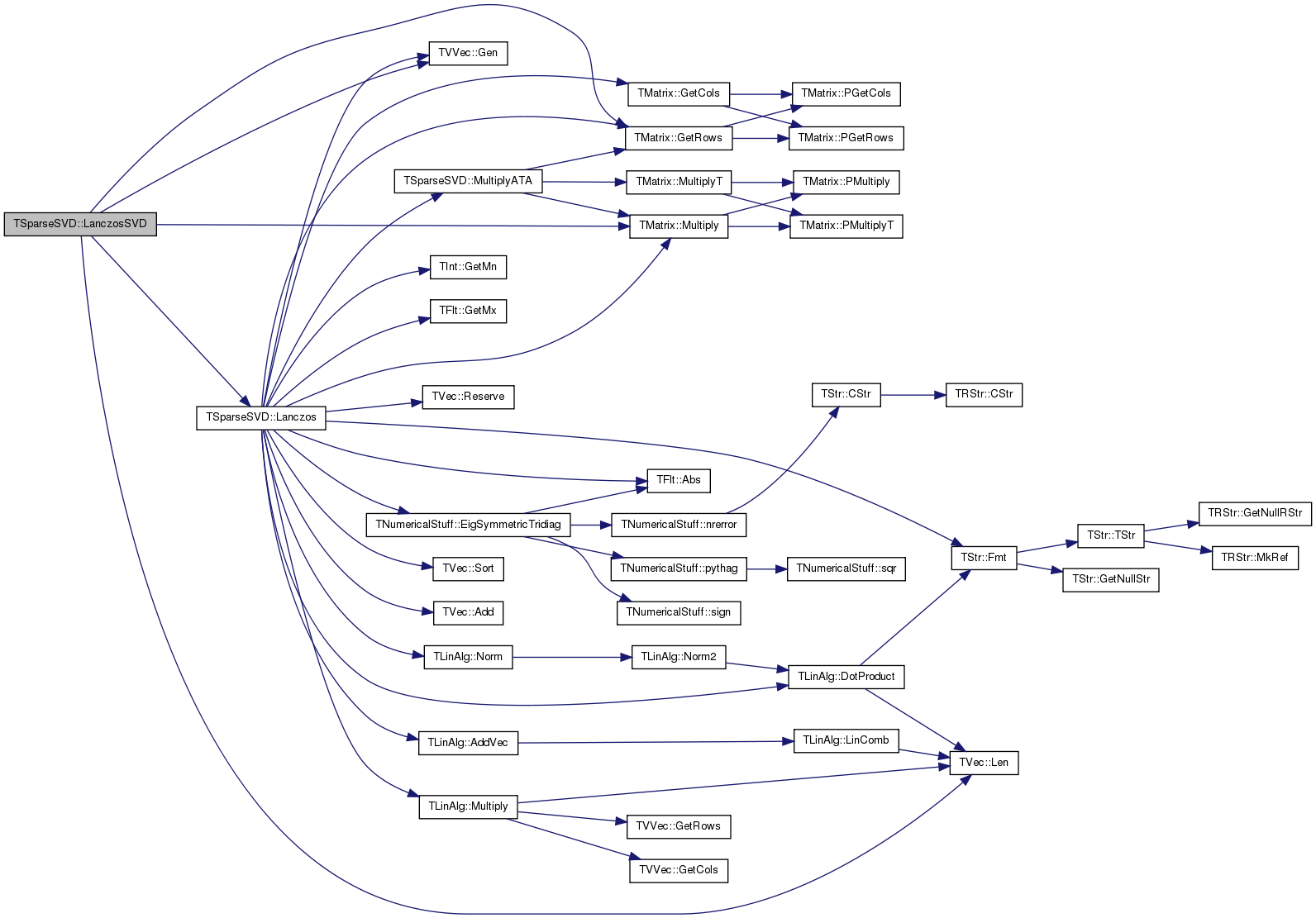
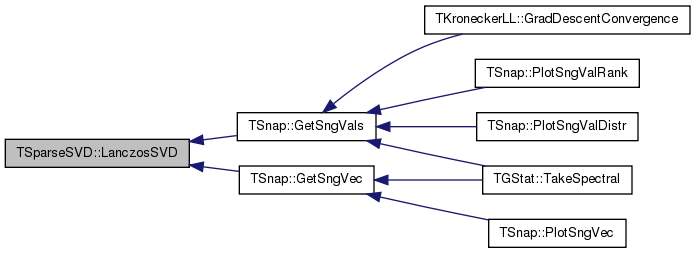
| void TSparseSVD::MultiplyATA | ( | const TMatrix & | Matrix, |
| const TFltVV & | Vec, | ||
| int | ColId, | ||
| TFltV & | Result | ||
| ) | [static, private] |
Definition at line 1000 of file linalg.cpp.
References TMatrix::GetRows(), TMatrix::Multiply(), and TMatrix::MultiplyT().
Referenced by Lanczos(), Lanczos2(), OrtoIterSVD(), and SimpleLanczos().
{
TFltV tmp(Matrix.GetRows());
// tmp = A * Vec(:,ColId)
Matrix.Multiply(Vec, ColId, tmp);
// Vec = A' * tmp
Matrix.MultiplyT(tmp, Result);
}
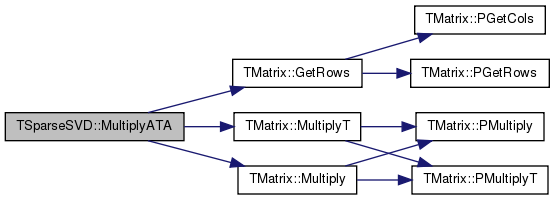

| void TSparseSVD::MultiplyATA | ( | const TMatrix & | Matrix, |
| const TFltV & | Vec, | ||
| TFltV & | Result | ||
| ) | [static, private] |
Definition at line 1009 of file linalg.cpp.
References TMatrix::GetRows(), TMatrix::Multiply(), and TMatrix::MultiplyT().
{
TFltV tmp(Matrix.GetRows());
// tmp = A * Vec
Matrix.Multiply(Vec, tmp);
// Vec = A' * tmp
Matrix.MultiplyT(tmp, Result);
}
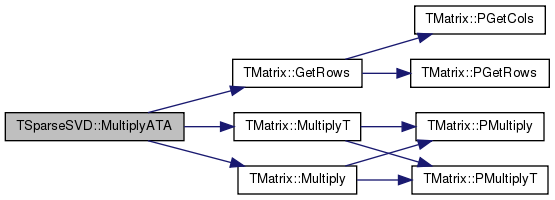
| void TSparseSVD::OrtoIterSVD | ( | const TMatrix & | Matrix, |
| int | NumSV, | ||
| int | IterN, | ||
| TFltV & | SgnValV | ||
| ) | [static] |
Definition at line 1018 of file linalg.cpp.
References TVec< TVal, TSizeTy >::Add(), TMatrix::GetCols(), TRnd::GetUniDev(), TLinAlg::GS(), MultiplyATA(), TLinAlg::Norm(), and TVec< TVal, TSizeTy >::Reserve().
{
int i, j, k;
int N = Matrix.GetCols(), M = NumSV;
TFltVV Q(N, M);
// Q = rand(N,M)
TRnd rnd;
for (i = 0; i < N; i++) {
for (j = 0; j < M; j++)
Q(i,j) = rnd.GetUniDev();
}
TFltV tmp(N);
for (int IterC = 0; IterC < IterN; IterC++) {
printf("%d..", IterC);
// Gram-Schmidt
TLinAlg::GS(Q);
// Q = A'*A*Q
for (int ColId = 0; ColId < M; ColId++) {
MultiplyATA(Matrix, Q, ColId, tmp);
for (k = 0; k < N; k++) Q(k,ColId) = tmp[k];
}
}
SgnValV.Reserve(NumSV,0);
for (i = 0; i < NumSV; i++)
SgnValV.Add(sqrt(TLinAlg::Norm(Q,i)));
TLinAlg::GS(Q);
}

| void TSparseSVD::Project | ( | const TIntFltKdV & | Vec, |
| const TFltVV & | U, | ||
| TFltV & | ProjVec | ||
| ) | [static] |
Definition at line 1466 of file linalg.cpp.
References TVec< TVal, TSizeTy >::Add(), TVec< TVal, TSizeTy >::Gen(), TVVec< TVal >::GetCols(), and TVec< TVal, TSizeTy >::Len().
{
const int m = U.GetCols(); // number of columns
ProjVec.Gen(m, 0);
for (int j = 0; j < m; j++) {
double x = 0.0;
for (int i = 0; i < Vec.Len(); i++)
x += U(Vec[i].Key, j) * Vec[i].Dat;
ProjVec.Add(x);
}
}
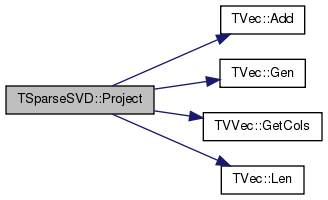
| void TSparseSVD::SimpleLanczos | ( | const TMatrix & | Matrix, |
| const int & | NumEig, | ||
| TFltV & | EigValV, | ||
| const bool & | DoLocalReortoP = false, |
||
| const bool & | SvdMatrixProductP = false |
||
| ) | [static] |
Definition at line 1050 of file linalg.cpp.
References TFlt::Abs(), TVec< TVal, TSizeTy >::Add(), TLinAlg::AddVec(), TLinAlg::DotProduct(), TNumericalStuff::EigSymmetricTridiag(), TLAMisc::FillIdentity(), TVec< TVal, TSizeTy >::Gen(), TMatrix::GetCols(), TMatrix::GetRows(), IAssert, TVec< TVal, TSizeTy >::Last(), TVec< TVal, TSizeTy >::Len(), TMatrix::Multiply(), MultiplyATA(), TLinAlg::MultiplyScalar(), TLinAlg::Norm(), and TVec< TVal, TSizeTy >::Sort().
Referenced by TSnap::GetEigVals(), and SimpleLanczosSVD().
{
if (SvdMatrixProductP) {
// if this fails, use transposed matrix
IAssert(Matrix.GetRows() >= Matrix.GetCols());
} else {
IAssert(Matrix.GetRows() == Matrix.GetCols());
}
const int N = Matrix.GetCols(); // size of matrix
TFltV r(N), v0(N), v1(N); // current vector and 2 previous ones
TFltV alpha(NumEig, 0), beta(NumEig, 0); // diagonal and subdiagonal of T
printf("Calculating %d eigen-values of %d x %d matrix\n", NumEig, N, N);
// set starting vector
//TRnd Rnd(0);
for (int i = 0; i < N; i++) {
r[i] = 1/sqrt((double)N); // Rnd.GetNrmDev();
v0[i] = v1[i] = 0.0;
}
beta.Add(TLinAlg::Norm(r));
for (int j = 0; j < NumEig; j++) {
printf("%d\r", j+1);
// v_j -> v_(j-1)
v0 = v1;
// v_j = (1/beta_(j-1)) * r
TLinAlg::MultiplyScalar(1/beta[j], r, v1);
// r = A*v_j
if (SvdMatrixProductP) {
// A = Matrix'*Matrix
MultiplyATA(Matrix, v1, r);
} else {
// A = Matrix
Matrix.Multiply(v1, r);
}
// r = r - beta_(j-1) * v_(j-1)
TLinAlg::AddVec(-beta[j], v0, r, r);
// alpha_j = vj'*r
alpha.Add(TLinAlg::DotProduct(v1, r));
// r = r - v_j * alpha_j
TLinAlg::AddVec(-alpha[j], v1, r, r);
// reortogonalization if neessary
if (DoLocalReortoP) { } //TODO
// beta_j = ||r||_2
beta.Add(TLinAlg::Norm(r));
// compoute approximatie eigenvalues T_j
// test bounds for convergence
}
printf("\n");
// prepare matrix T
TFltV d(NumEig + 1), e(NumEig + 1);
d[1] = alpha[0]; d[0] = e[0] = e[1] = 0.0;
for (int i = 1; i < NumEig; i++) {
d[i+1] = alpha[i]; e[i+1] = beta[i]; }
// solve eigne problem for tridiagonal matrix with diag d and subdiag e
TFltVV S(NumEig+1,NumEig+1); // eigen-vectors
TLAMisc::FillIdentity(S); // make it identity
TNumericalStuff::EigSymmetricTridiag(d, e, NumEig, S); // solve
//TLAMisc::PrintTFltV(d, "AllEigV");
// check convergence
TFltKdV AllEigValV(NumEig, 0);
for (int i = 1; i <= NumEig; i++) {
const double ResidualNorm = TFlt::Abs(S(i-1, NumEig-1) * beta.Last());
if (ResidualNorm < 1e-5)
AllEigValV.Add(TFltKd(TFlt::Abs(d[i]), d[i]));
}
// prepare results
AllEigValV.Sort(false); EigValV.Gen(NumEig, 0);
for (int i = 0; i < AllEigValV.Len(); i++) {
if (i == 0 || (TFlt::Abs(AllEigValV[i].Dat/AllEigValV[i-1].Dat) < 0.9999))
EigValV.Add(AllEigValV[i].Dat);
}
}
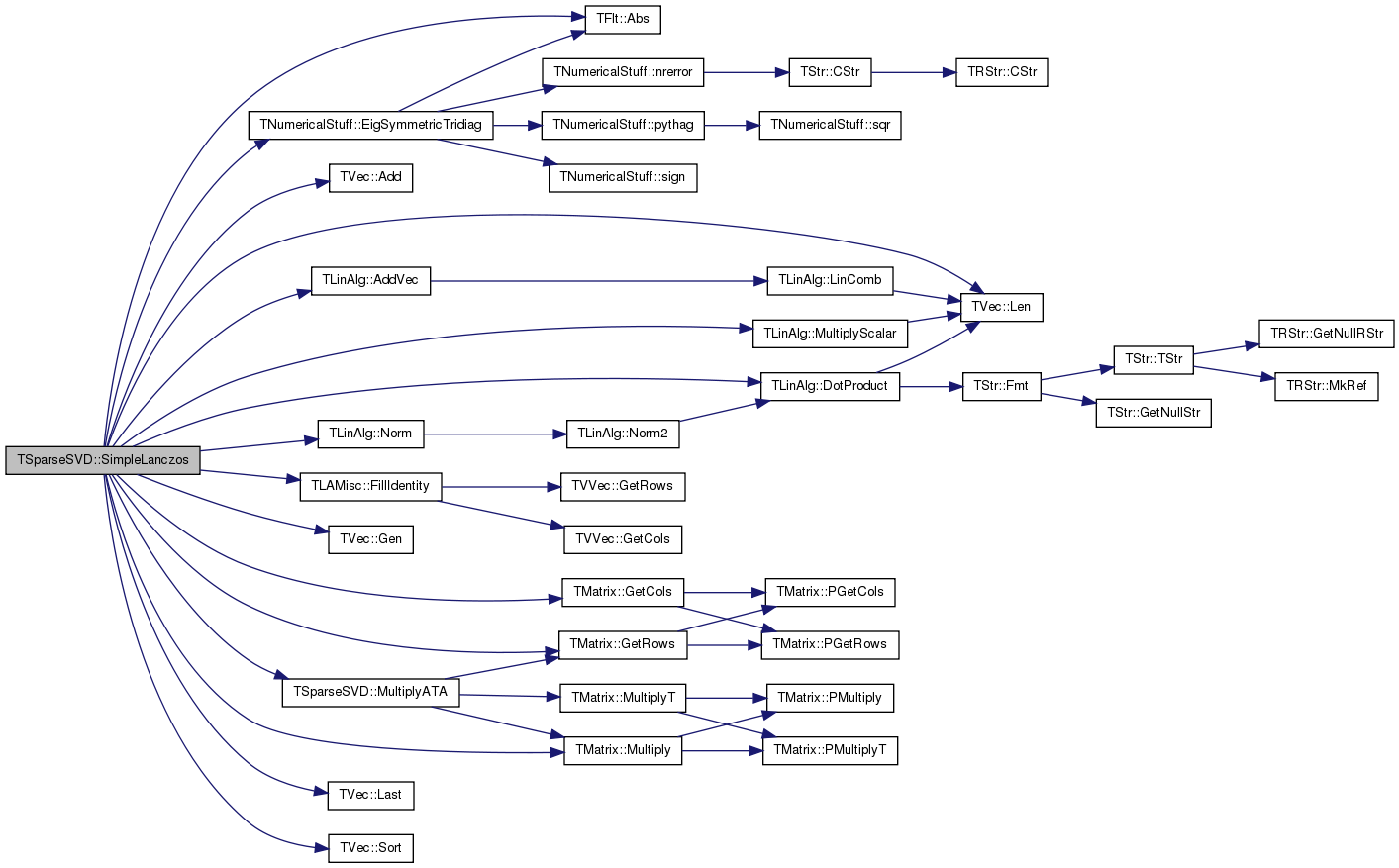

| void TSparseSVD::SimpleLanczosSVD | ( | const TMatrix & | Matrix, |
| const int & | CalcSV, | ||
| TFltV & | SngValV, | ||
| const bool & | DoLocalReortoP = false |
||
| ) | [static] |
Definition at line 1430 of file linalg.cpp.
References TVec< TVal, TSizeTy >::Len(), and SimpleLanczos().
Referenced by TSnap::GetSngVals().
{
SimpleLanczos(Matrix, CalcSV, SngValV, DoLocalReorto, true);
for (int SngValN = 0; SngValN < SngValV.Len(); SngValN++) {
//IAssert(SngValV[SngValN] >= 0.0);
if (SngValV[SngValN] < 0.0) {
printf("bad sng val: %d %g\n", SngValN, SngValV[SngValN]());
SngValV[SngValN] = 0;
}
SngValV[SngValN] = sqrt(SngValV[SngValN].Val);
}
}
